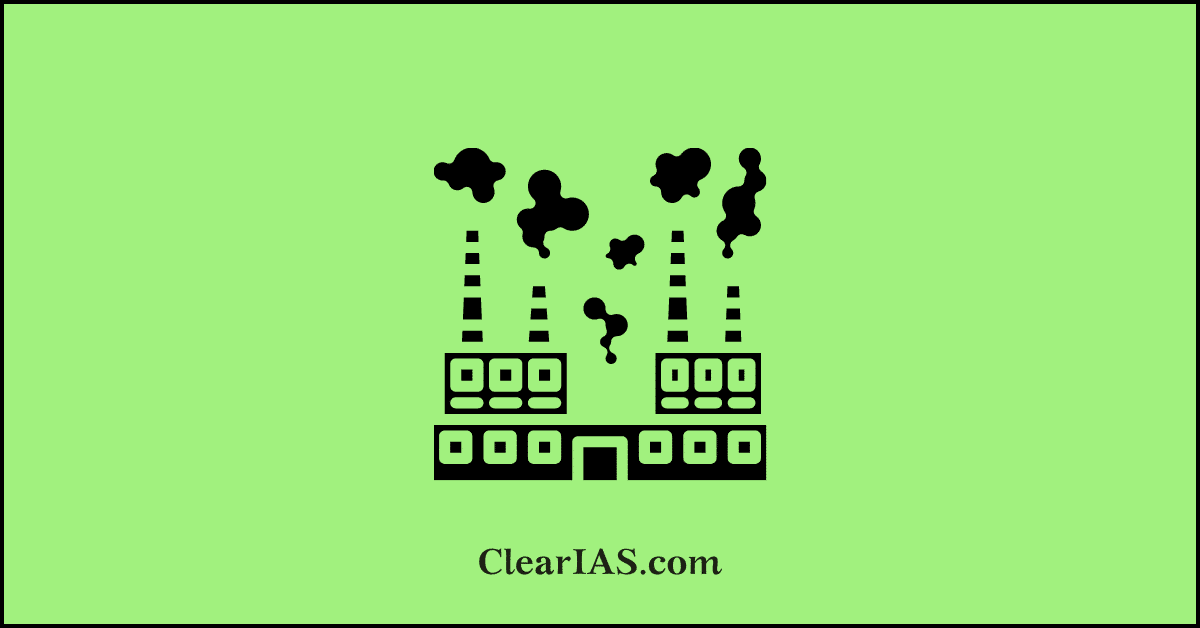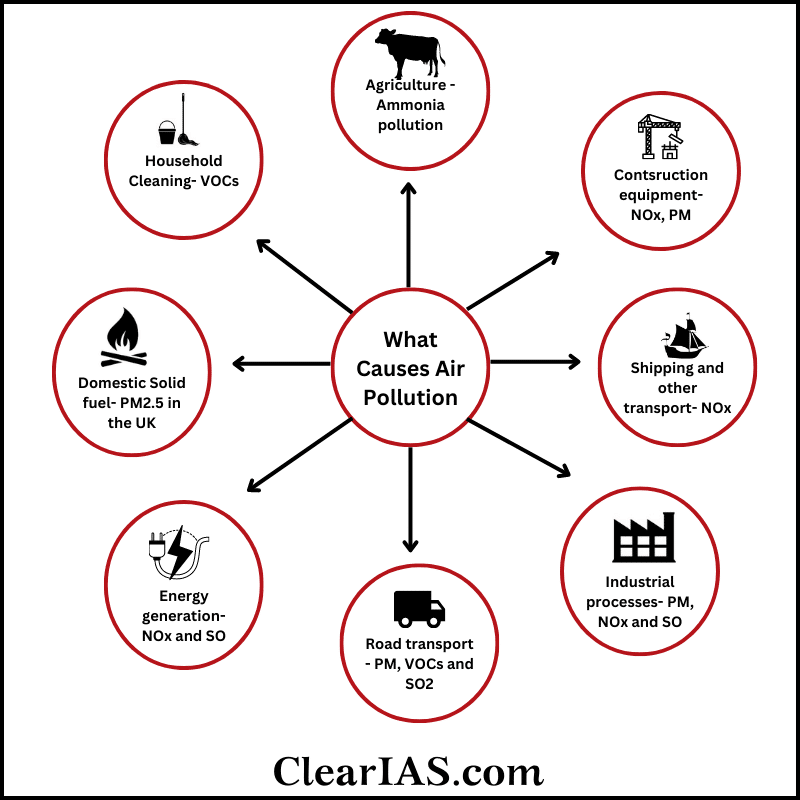 As we all know, modernization impacts positively as well as negatively. Pollution is one of the negative impacts, which leads to a threat to our earth. This article deals about Air pollution.
As we all know, modernization impacts positively as well as negatively. Pollution is one of the negative impacts, which leads to a threat to our earth. This article deals about Air pollution.
Air Pollution is one of the most important topics for the UPSC Civil Services Exam.
As we all know Poor air quality is a danger to public health.
Let’s discuss all about this Air Pollution.
What is Air Pollution?
Air pollution is the presence of compounds (air pollutants) in the atmosphere that are hazardous to human health and the health of other living things or impair the climate or materials.
What are Air pollutants?
There are many different types of air pollutants, such as gases (such as ammonia, carbon monoxide, sulfur dioxide, nitrous oxides, methane, carbon dioxide, and chlorofluorocarbons), particulates (both organic and inorganic), and biological molecules.
Then, what do you mean by primary and secondary pollutants?
Primary Pollutants: The pollutants that directly cause air pollution are known as primary pollutants.
Secondary Pollutants: Secondary pollutants are those that are produced as a result of the mixing and interaction of primary pollutants.
Air pollution may cause diseases, allergies, and even death to humans.
Additionally, it may hurt other living things like animals and food crops, as well as impair the built environment or the natural environment (for instance, by causing climate change, ozone depletion, or habitat destruction) (for example, acid rain).
Both human activity and natural processes can generate air pollution.
Read more about Photo chemical smog Click here
Source of Air Pollution

- Burning of Fossil Fuels: The majority of pollutants are created when fossil fuels or wood are burned for transportation, heating, industrial processes, and power plants.
- Agriculture & Allied Sources: A common example of a source of pollution is farming, where ammonia from fertilizers and livestock manure blows into cities and forms particles, especially in the spring when crops are seeded and muck is spread.
- Further, stubble burning is also one of the major sources of air pollution in northern India, especially in winter.
- Natural Sources: Apart from it, there are some natural sources of outdoor air pollution such as dust storms.
- Around Delhi, there are thermal power plants, and the dirty air spreads to the nearby cities. A lot of companies use very polluting high-sulfur oil.
There are substantial amounts of solid garbage. Farmers in Punjab and Haryana burn crop leftovers on a seasonal basis.
Due prepare their fields for the following crop, and during the winter, when the air is dense, there is a temperature inversion, and there is very little pollution dispersion.
During winter we also see people burning fires at night to bear the cold. All this put together has a cumulative effect on the air quality.
- fumes formed from aerosol sprays, paint, hair spray, varnish, and other solvents. These can be significant; in the Los Angeles basin in the 2010s, it was estimated that emissions from these sources were responsible for about half of the volatile organic compound pollution.
- Waste deposition in landfills generates methane. Methane is highly flammable and may form explosive mixtures with air.
Methane can displace oxygen in an enclosed environment and is an asphyxiant as well. If the oxygen concentration is displaced below 19.5%, asphyxia or suffocation may occur.
Air pollution is usually thought of as smoke from large factories or exhaust from vehicles.
But there are many types of indoor air pollution as well.
Do you know Indoor Air Pollution?
Heating a house by burning substances such as kerosene, wood, and coal can contaminate the air inside the house.
Ash and smoke make breathing difficult, and they can stick to walls, food, and clothing.
Naturally-occurring radon gas, a cancer-causing material, can also build up in homes. Radon is released through the surface of the Earth. Low-cost solutions put in place by experts can lower radon levels.
Insulation is one of the building supplies that can be harmful to people’s health. Additionally, the movement of air in buildings and spaces can promote the growth of harmful mould.
A single mould colony could exist in a home’s moist, chilly areas, including in the spaces between walls.
The airborne spores of the mould spread throughout the entire house. The spores can make people unwell if they breathe them in.
Regulations for Air Pollution
The majority of affluent nations have passed rules to control emissions and lower air pollution in addition to the international Kyoto Protocol.
A cap and trade system to control emissions is the topic of discussion in the US. The quantity of pollution a corporation is permitted under this approach would be capped, or set at a certain level. Companies would be required to pay if they went over their cap.
Companies could trade or sell their leftover pollution allowance to other businesses if they exceeded their cap but did not exceed it.
In essence, cap and trade would pay businesses to reduce pollution.
The World Health Organization updated its air quality recommendations in 2006. The WHO recommendations are stricter than the majority of individual nations’ current recommendations.
The WHO recommendations are designed to lower annual air pollution-related mortality by 15%.
Consequences of Air Pollution:
- Pollution is responsible for a significant number of deaths (about 2000), which is highly alarming. Since the numbers are simply estimates, they could not be accurate.
To obtain precise data, a thorough study is needed, but neither the time nor the money is available, nor are there enough people to carry it out. As a result, we must address the problem of pollution cautiously.
- Between 1990 and 2015, India saw a 50% increase in premature deaths associated with PM 2.5, practically at the same time as economic liberalization.
- Because pollutants enter the lungs deep inside, the lungs’ ability to cleanse blood is lowered, which has an impact on a person’s ability to grow, think clearly, and function, particularly in youngsters, pregnant women, and the elderly.
- Air quality has also become a severe health concern.
- Poor people are more vulnerable to air pollution because they are the ones who spend more time on roads.
What is the National Air Quality Index?
Launched in 2014 with an outline ‘One Number – One Color -One Description’ for the common man to judge the air quality within his vicinity.
The measurement of air quality is based on eight pollutants, namely: Particulate Matter (PM10), Particulate Matter (PM2.5), Nitrogen Dioxide (NO2), Sulphur Dioxide (SO2), Carbon Monoxide (CO), Ozone (O3), Ammonia (NH3), and Lead (Pb).
AQI has six categories of air quality. These are: Good, Satisfactory, Moderately Polluted, Poor, Very Poor, and Severe.
It has been developed by the CPCB in consultation with IIT-Kanpur and an expert group comprising medical and air-quality professionals.
Categorization of Air Quality under AQI:
| AQI | Remark | Colour Code | Possible Health Impacts | |
| 0-50 | Good |
|
Minimal Impact | |
| 51-100 | Satisfactory |
|
Minor breathing discomfort in sensitive people | |
| 101-200 | Moderate |
|
Breathing discomfort to people with asthma and heart disease. | |
| 201-300 | Poor |
|
Breathing discomfort to most people on prolonged exposure. | |
| 301-400 | Very Poor |
|
Respiratory illness on prolonged exposure | |
| 401-500 | Severe |
|
Affects healthy people and seriously impacts those with existing diseases. |
Measures to improve air quality:
- Improving public transport
- Limiting the number of polluting vehicles on the road
- Introducing less polluting fuel
- Strict emission regulations
- Improved efficiency for thermal power plants and industries
- Moving from diesel generators to rooftop solar
- Increased use of clean renewable energy
- Electric vehicles
- Removing dust from roads
- Regulating construction activities
- Stopping biomass burning, etc.
System of Air Quality and Weather Forecasting And Research
- SAFAR is a national program launched by the Ministry of Earth Sciences (MoES) to assess both the city’s overall pollution level and its local air quality to gauge how clean the air is in a major metropolis.
- The system is indigenously developed by the Indian Institute of Tropical Meteorology (IITM), Pune, and is operationalized by the India Meteorological Department (IMD).
- The project’s ultimate goal is to raise public awareness of the state of the air in their community so that proper remedial action and organized action can be performed.
- SAFAR is an integral part of India’s first Air Quality Early Warning System operational in Delhi.
- It monitors all weather parameters like temperature, rainfall, humidity, wind speed, wind direction, UV radiation, and solar radiation.
- Pollutants Monitored:5, PM10, Ozone, Carbon Monoxide (CO), Nitrogen Oxides (NOx), Sulfur Dioxide (SO2), Benzene, Toluene, Xylene, and Mercury.
Way Forward
- WHO’s 4 Pillar Strategy: WHO adopted a resolution (2015) to address the adverse health effects of air pollution. There is a need to adhere to a roadmap highlighted under this.
This 4-pillar strategy calls for an enhanced global response to the adverse health effects of air pollution. Those four pillars are:
-
- Expanding the knowledge base
- Monitoring and reporting
- Global leadership and coordination
- Institutional capacity strengthening
- Proactive Measure: It is important to encourage interventions like pollution-monitoring apps so that individuals can opt to avoid bad travel times and choose alternate city walking routes that keep them away from the places with the poorest air quality.
The application of the Graded Response Action Plan in the Delhi-National Capital Region (NCR) is a step in the right direction.
- Innovative Measure: There is a need to adopt innovative solutions for the in-situ treatment of pollution.
For example, the Delhi government is also experimenting with a new organic way of decomposing stubble with Indian Agriculture Research Institute’s “Pusa decomposer”.
- Responsibility of Citizens: Even though there are many suggestions and methods for reducing air pollution, the problem persists. This is a result of a lack of strong political will and public involvement. As a result, people should keep advocating for their right to safe and sustainable surroundings and hold governments responsible.
- Addressing Injustice: Since the poorest individuals are also those who are most exposed to air pollution, there are major injustices at the root of the problem. As a result, the Polluter Pay Principle must be followed and industries that produce pollution must pay a fee to protect the environment.
Fighting air pollution is a public concern, hence it is within everyone’s purview. As a result, there is a need for focused, coordinated activities that include all relevant parties.
The government (federal, state, and municipal), cities, the general public, and individuals should all be considered in this.
Further, there is a need for a policy that envisages a healthy energy transition and healthy urban planning transition.
Read: GRAP
Article Written by: Remya





Leave a Reply